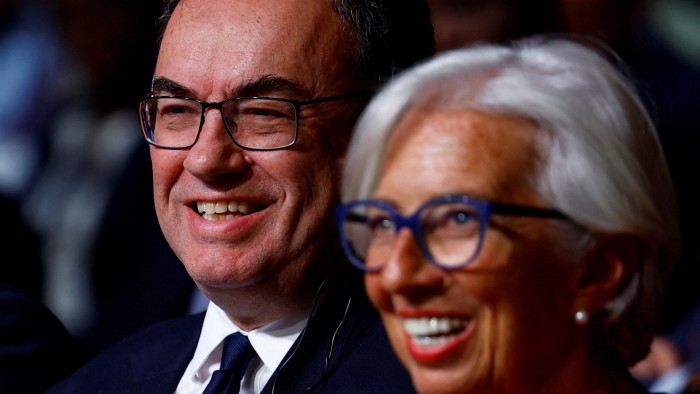In frequently declaring their monetary policy setting to be “restrictive”, European Central Bank president Christine Lagarde and Bank of England governor Andrew Bailey have raised the immediate follow-up question: what is the neutral level of interest rates, neither constraining nor stimulating economic activity?
Luckily for us, both central banks published their latest assessments of natural/neutral rates late last week, allowing me to compare and contrast. One thing to note is that I am making no distinction between natural and neutral rates here. The ECB likes the word “natural”, while the BoE prefers “neutral”. They are talking about the same concept.
There are many similarities in their assessments and, for additional spice, they both managed to insert a glaring contradiction for our delight.
Where is the neutral rate?
Both the ECB and BoE stressed that the neutral rate is highly uncertain and can only be described as a range, which might change.
In nominal terms, Lagarde said in Davos that the range of neutrality lay between 1.75 per cent and 2.25 per cent. Not surprisingly, this is also the range outlined in the ECB’s formal assessment.
The BoE’s assessment was more cautious, harking back to previous work from 2018, which highlighted a range of 2 to 3 per cent with a modal estimate of 2.25 per cent. It now thinks the range is a bit higher, but is very uncertain about how much. Deputy governor Claire Lombardelli said: “You know, you can add all that up and say perhaps we’re in the region of 2 to 4 [per cent]. It’s very broad.”
The benefit of both these assessments is that current interest rates are above these levels, so officials can say they are restrictive without further qualification.
Do officials use these estimates?
Yes and no. The neutral rate number sits in the background within many macroeconomic models providing a gravitational force, gently pulling forecasts towards this equilibrium in time. They also help officials think about the degree of stimulus or restrictiveness in the stance of the central banks’ policy.
But both banks stressed that on a day-to-day basis, the estimates of neutrality do not loom large.
The ECB said its estimates should not be taken very seriously. “These cannot be seen as a mechanical gauge of appropriate monetary policy at any point in time,” it said, and highlighted (again) that the bank takes decisions based on the inflation outlook, the dynamics of underlying inflation and its assessment of the effect of monetary policy on the economy.
The BoE said its assessment of the neutral rate “plays a role” in policy setting, but this comes alongside many other considerations including financial conditions, trends in household savings, surveys of market participants and assessments of the economic cycle. Bailey said: “There is a high degree of uncertainty around this and, as we say, that’s why we don’t use it for setting interest rates.”
Why is the neutral rate so darn uncertain?
Because the neutral rate is a theoretical concept, it cannot be measured and can only be estimated within economic models. Different models will produce different results. Each will produce a range of plausible answers and the latest estimates, which, while most useful for policymaking, are also the least certain and most prone to revision.
The ECB did a rather better job than the BoE in highlighting the uncertainties. It published estimates with confidence bounds and, unlike the BoE, did not publish guesswork about the reasons for potential recent movements in neutral rates.
The chart below shows various estimates of the Eurozone’s neutral rate. To keep everything nominal, I have added 2 percentage points to each number in the chart, so it is slightly different from the original. It shows a wide range and you can see Lagarde’s 1.75 to 2.25 per cent estimates in the blue and yellow shading along with the ECB’s current interest rate at 2.75 per cent.
The ECB’s concern about a wide potential range of neutral rate estimates is shown in the second chart, which focuses on the Holsten, Laubach and Williams model collated by the New York Fed. Apart from the scale of revisions, early estimates are often far from later estimates for the same period, showing the difficulty of using this data in real time.
The glaring contradictions
Many of you will already have noticed the glaring contradiction in the ECB work because it is on show in the charts. Lagarde said the neutral range was 1.75 per cent to 2.25 per cent, but that is true only if you ignore the HLW measure which, the ECB itself noted, had a nominal range between 1.75 per cent and 3 per cent. Including all the measures, it is no longer clear that ECB policy is restrictive in comparison with estimates of neutral.
The ECB sought to explain this inconsistency by saying the 1.75 per cent to 2.25 per cent range included all measures “for which an update to the end of 2024 is available”. You have to wonder whether this form of words was used because the president had declared the neutral range in a TV interview in January.
The glaring contradiction from the BoE is that both officials and Bailey stated confidently that the neutral rate was a “global concept” not a domestic UK measure. The problem was that the 2 to 3 per cent range from the 2018 analysis was specific to the UK and much of the wider BoE analysis, such as wondering if there will be a higher neutral rate due to looser fiscal policy in future, does not match current UK fiscal plans.
It is lucky that European central banks do not put a lot of policy weight on these estimates of neutral. The numbers are uncertain and the analysis does not stand up well under scrutiny.
In his interview with the FT last week, the Finnish central bank governor Olli Rehn put it well when he said the following:
We should not constrain our freedom of action because of a theoretical concept, which is nice to talk about when you have a pint in the pub, but it’s not suitable as a concrete benchmark for monetary policy . . .
I’m actually fascinated by the discussion and always have been. But the more one studies it, the more one realises the uncertainties
Bessent’s brave bet
Fresh from the humiliation of suggesting the Donald Trump administration would move gradually with tariffs only to be blown away by the president’s announcement of huge levies on Mexico and Canada, Treasury secretary Scott Bessent has made another public bet.
Speaking about Trump, Bessent said that “he and I are focused on the 10-year Treasury”, when talking to Fox Business last week. “He is not calling for the Fed to lower rates.”
That’s quite a bet, since Trump has regularly called for the Fed to cut rates. Bessent doubled down later in the week when talking to Bloomberg. “We are not focused on whether the Fed is going to cut [or] not cut, we are focused on lowering rates, so we are less focused on the specific of rate cuts and [instead] how do we get the whole curve down.”
His confidence is brave. And I say that using the British civil service meaning of the word — foolhardy.
What I’ve been reading and watching
-
I wrote about why US and European monetary policy was likely to diverge
-
Ahead of Jay Powell’s testimony to Congress this week, members of the Federal Open Market Committee have been downplaying the chances of rate cuts in the near future. You can read speeches from Lorie Logan, Austan Goolsbee and Adriana Kugler here, or see an updated summary of central bank views on the FT’s Monetary Policy Radar
-
Catherine Mann became the most interesting member of the BoE’s Monetary Policy Committee by shifting from being the most hawkish to seeking an immediate half-point cut last week. The FT interviewed her after the decision and asked why she changed her mind. Full transcript on Monetary Policy Radar
A chart that matters
The BoE generated huge amounts of alarmist media coverage last week about it “halving” its growth forecast for 2025. Actually, as the chart below shows, the forecast for 2025 was barely changed from November and subsequent growth was revised higher.
What had changed was that the BoE had recognised there had been no growth in the final two quarters of 2024.
I was surprised by how difficult it was to gather the data in the chart below. (You have to download two different spreadsheets from separate obscure zip files, ask the BoE to remove password protection on one of them and then merge the data).
Given the horrible headlines the next day, perhaps it is time to retire headline forecasts based on annual average GDP levels. In these figures, the previous year is just as important as the year of the “forecast”, so people always misunderstand the results.
The BoE (and the ECB) could learn from the Fed, which publishes Q4 2025 over Q4 2024 forecasts and will always avoid this type of misunderstanding.
Source link











